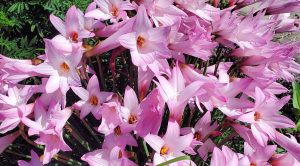
The rains have finally returned to the relief of all of our plants. Rain often triggers growth and flowering as well – if you have seen rain lilies, you will know what I mean. Rain lilies have burst forth in a blaze of glory with this recent deluge of rain across our Charlotte County landscape. It is interesting that while I can hand water my rain lilies and not stimulate any flowers, it only took one good natural rain and they exploded into bloom almost overnight!
There are a number of native rain lilies in Florida and others that range through Mexico, Central America, and South America. There are also many cultivated types often called Zephyr lilies, fairy lilies and rain lilies. Probably one of the most popular rain lilies is Zephyranthes grandifolia with light-pink, six-petaled flowers. I have one clump which recently shot up dozens and dozens of almost three-inch wide blooms! Other types available are white and yellow representing different species. Hybrids may also be available with apricot-colored flowers. Rain lilies are all bulbous plants which form clumps of thin, twelve-inch long, strap-like foliage reminiscent of liriope. Over the years these clumps will enlarge and may need to be divided. Wait until they finish flowering in the fall to divide the clumps and replant them in compost-enhanced soil. Excess bulbs can also be given to a friend or neighbor as a “pass-along” plant.
Plant rain lilies in full sun to part-shade as produced by the dappled shade of trees in groundcover beds. Rain lilies also do well in pots and do especially well when pot bound. An eight-inch pot with twelve bulbs will send up several sets of flowers over the season. Use perennial rain lilies in rock gardens and in mass plantings for the best shows.
You can obtain rain lilies from friends and neighbors or through various bulb companies. Keep in mind that this plant is poisonous – toxic alkaloids – so keep this in consideration around children and pets.
You will be pleasantly surprised when a summer rain is followed by a short-term, but glorious, living bouquet of flowers provided by the tried-and-true rain lily – a Florida-Friendly Landscaping™ approved plant! For more information on all types of flowering bulbs suitable for our area, or to ask a question, you can also call the Master Gardener Volunteer Helpdesk on Mondays, Wednesdays, and Fridays from 1 to 4 pm at 764-4340 for gardening help and insight into their role as an Extension volunteer. Ralph E. Mitchell is the Director/Horticulture Agent for UF/IFAS Extension – Charlotte County. He can be reached at 941-764-4344 or ralph.mitchell@charlottecountyfl.gov. Connect with us on social media. Like us on Facebook @CharlotteCountyExtension and follow us on Instagram @ifascharco.
Resources:
Knox G. W. (2021) RAINLILY, ZEPHYRANTHES AND HABRANTHUS SPP.: LOW-MAINTENANCE FLOWERING BULBS FOR FLORIDA GARDENS. The University of Florida Extension Services, IFAS.
Gilman, E. F., Klein, R. W. & Hansen, G. (2024) ZEPHYRANTHES SPP. RAIN LILY. The University of Florida Extension Services, IFAS.
The Florida-Friendly Landscaping Guide to Plant Selection & Landscape Design (2022) The University of Florida Extension Services, IFAS.
UF/IFAS Gardening Solutions (2024) Rain Lily. The University of Florida Extension Services, IFAS.
Mahr, S. (2014) Zephyranthes grandifolia. University of Wisconsin – Extension.
 1
1
